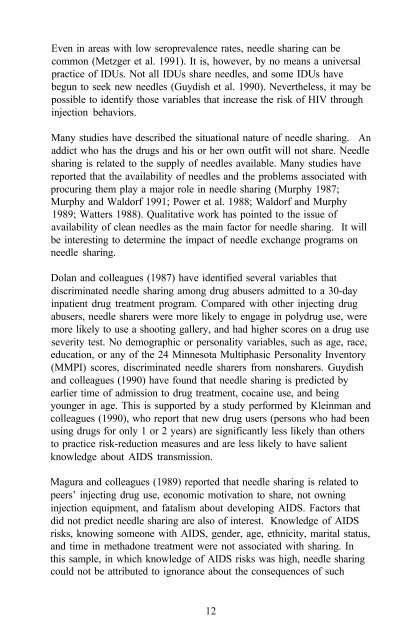The Context of HIV Risk Among Drug Users and Their Sexual Partners
The Context of HIV Risk Among Drug Users and Their Sexual Partners
The Context of HIV Risk Among Drug Users and Their Sexual Partners
Create successful ePaper yourself
Turn your PDF publications into a flip-book with our unique Google optimized e-Paper software.
Even in areas with low seroprevalence rates, needle sharing can be<br />
common (Metzger et al. 1991). It is, however, by no means a universal<br />
practice <strong>of</strong> IDUs. Not all IDUs share needles, <strong>and</strong> some IDUs have<br />
begun to seek new needles (Guydish et al. 1990). Nevertheless, it may be<br />
possible to identify those variables that increase the risk <strong>of</strong> <strong>HIV</strong> through<br />
injection behaviors.<br />
Many studies have described the situational nature <strong>of</strong> needle sharing. An<br />
addict who has the drugs <strong>and</strong> his or her own outfit will not share. Needle<br />
sharing is related to the supply <strong>of</strong> needles available. Many studies have<br />
reported that the availability <strong>of</strong> needles <strong>and</strong> the problems associated with<br />
procuring them play a major role in needle sharing (Murphy 1987;<br />
Murphy <strong>and</strong> Waldorf 1991; Power et al. 1988; Waldorf <strong>and</strong> Murphy<br />
1989; Watters 1988). Qualitative work has pointed to the issue <strong>of</strong><br />
availability <strong>of</strong> clean needles as the main factor for needle sharing. It will<br />
be interesting to determine the impact <strong>of</strong> needle exchange programs on<br />
needle sharing.<br />
Dolan <strong>and</strong> colleagues (1987) have identified several variables that<br />
discriminated needle sharing among drug abusers admitted to a 30-day<br />
inpatient drug treatment program. Compared with other injecting drug<br />
abusers, needle sharers were more likely to engage in polydrug use, were<br />
more likely to use a shooting gallery, <strong>and</strong> had higher scores on a drug use<br />
severity test. No demographic or personality variables, such as age, race,<br />
education, or any <strong>of</strong> the 24 Minnesota Multiphasic Personality Inventory<br />
(MMPI) scores, discriminated needle sharers from nonsharers. Guydish<br />
<strong>and</strong> colleagues (1990) have found that needle sharing is predicted by<br />
earlier time <strong>of</strong> admission to drug treatment, cocaine use, <strong>and</strong> being<br />
younger in age. This is supported by a study performed by Kleinman <strong>and</strong><br />
colleagues (1990), who report that new drug users (persons who had been<br />
using drugs for only 1 or 2 years) are significantly less likely than others<br />
to practice risk-reduction measures <strong>and</strong> are less likely to have salient<br />
knowledge about AIDS transmission.<br />
Magura <strong>and</strong> colleagues (1989) reported that needle sharing is related to<br />
peers’ injecting drug use, economic motivation to share, not owning<br />
injection equipment, <strong>and</strong> fatalism about developing AIDS. Factors that<br />
did not predict needle sharing are also <strong>of</strong> interest. Knowledge <strong>of</strong> AIDS<br />
risks, knowing someone with AIDS, gender, age, ethnicity, marital status,<br />
<strong>and</strong> time in methadone treatment were not associated with sharing. In<br />
this sample, in which knowledge <strong>of</strong> AIDS risks was high, needle sharing<br />
could not be attributed to ignorance about the consequences <strong>of</strong> such<br />
12
















